#New Image International Beauty Institute
Explore tagged Tumblr posts
Text
Best Beauty Institute in Shahabad | NIIB Shahabad

NIIB Beauty Institute in Shahabad is focused on empowering the beauty aspirants of Uttar Pradesh with all the latest knowledge of beauty and wellness. As a part of India’s fastest-growing beauty academy, we offer a wide range of courses designed to equip our students with the skills and knowledge needed to excel in the beauty industry. Our state-of-the-art facilities and experienced faculty ensure that every student receives the best possible training
ABOUT ACADEMY
New image international beauty institute professional trainers make sure that you practically learn in the field of beauty & wellness.
NIIB institute provides courses based on the current trends in collaboration with industry experts teaching you the latest beauty & makeup techniques.
We offer truly unparalleled education with trained and certified faculty who has experience in the beauty industry.
NIIB is one of the few professional educational institutions in the globally connected that provide training & hands-on courses in cosmetology, hair, skin, nail, etc who are willing to explore and attain scientific excellence in this field.
If you want to learn new techniques of Beauty ?
Come & join NIIB institute as we have something for you! Our institute introduced different courses/workshops & professional upgraded make-up courses to cover all your beauty related aspirations. Not only this, we are also providing exclusive permanent makeup and dermatology courses which is getting viral globally. So, if you are seriously considering beauty makeup as your profession, then it is high time to consider joining NIIB institute to upgrade yourself as pro in beauty & wellness.
Additionally, the innovative techniques we use in delivering the courses and the latest equipment involved in our labs have been drawing attention of many students who are keen on enrolling in our institute as our every lab is equipped with relatable tools and material to help students get ready for industry right from their classes itself.
NIIB Institute also provides so many courses like short term courses, cooking courses, hobby courses in which you can learn trending techniques and in just a short span of time with international certifications:
Permanent makeup
Professional Makeup
Dermatology
Nail Extensions
Hair Styles & Treatments
Ayurvedic Spa
0 notes
Text
#Makeup Courses in Ludhiana#Beauty Parlour Course In Ludhiana#New Image International#NIIB Institute
0 notes
Text
celebrating palestinian science
in the face of israels' targetting of scholars, scientists and intellectuals...
saw a tumblr post by @/anarchistfrogposting that got me heavythinking about the relevance of language and culture in chemistry and science, it's unfortunate english has been accepted as its' lingua franca and most other input is lost to the globalization of this change. formulae and structure are essential and in a subject so specific, the average chemist will need to memorize hundreds of chemistry-specific words, and it becomes a barrier past entry when direct translating gets murky. deconstructing the history of science will always lead to political waters as the politicization of science and populist anti-intellectualism ethos rooted itself since the beginning of the study and these implicit biases result in a lack of consensus amongst borders.
before wwi the geographical spread of language in science was much more diverse, a lot of french and german researchers were common in research publishing, but after the allies established new scientific institutions that excluded germans and the isolationist decades that followed suit, foreign-language education was reductionist and excised globally as a result of elitism, being a language considered spoken only 'by the educated'. english-language proficiency is undeniably a prerequisite when an inexaggerated count of 99% of natural science papers are published in english, starting since 2015. this is a /heavily/ debated and discoursed topic and is terribly intimidating to sink your teeth into because of globalization of english and the complexity of modern language but getting over this hurdle will blossom a culturally rich rabbit hole to go down and it is all super interesting. there is so much great palestinian scientific practices, not as in western scientists work imagined in palestinian hands, but palestinian-born theories and practices. i think it's really integral, to always, but especially during times like these to uplift the people of palestine and their beauty just as much as funnel hatred toward their oppressors and murderers.
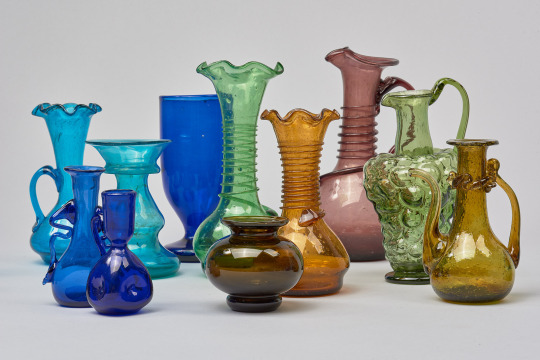
==
[image ID: a lineup of various glass pots and vases, ranging in color and size, placed in front of a plain background. end]
this is a specific sort of glass called 'hebron glass' which is an extremely renowned palestinian practice and passed down traditionally through multiple families and businesses. dating back as far as the 100~s in BCE, their technique of glassblowing was far ahead of their time and not used commonly anywhere else until much further in BCE. the /exact/ practice of hebron glass is kept a family secret amongst palestinian businesses, but a metal tool called 'kammasha' is used to blow the glass. a palestinian artisan talks about the process in more length here, i would recommend doing extended reading directly from palestine:
the colors are so vibrant and beautiful, i am endlessly impressed by how elegant these pieces have been made since the middle ages. these pieces and techniques have inspired a lot of famous modern day forms of glassblowing and glass artistry, most notably the venetian glass of venice.
i include this under science as much as it is art because it often goes unseen how much temperature and calculation goes into this craft. its highly skilled and intense work to bend over the hot flames and handle the glass in such a vulnerable state that could easily shatter. the material is more than 1800F and the palestinian kammasha is very carefully timed.

==
[image ID: an online video call meeting titled 'School on Synchrotron Light Sources and their Applications' at the top. end]
what you're looking at right now is the SESAME initiative run by the international centre for theoretical physics. a famous alumnus of this school was sufyan tayeh, a palestinian scientist. he was a prominent researcher and mentor and advocate for international understanding through science, introducing: SESAME, an alternative vision for the future of peaceful coexistence and cooperation and offered a meeting point around the globe to speak the common language of science, making communication possible. sufyan tayeh was an inspiration and bridge builder for all of these young students and an entry point for future scientists. he was a winner of multiple awards for his contributions to science and was appointed chair man for UNESCO (united nations educational, scientific and cultural organization) and head of physical, astrophysical and space sciences in palestine. he was regarded as a leading researched in science and applied mathematics globally, and tragically was killed in the current genocide. this is one case of many, many palestinian researchers. the impact of their contributions are insurmountable and irreplaceable.

==
[image ID: a list documenting the 45 palestinian scholars killed by israel since october 7th: Sufian Tayeh, Mohammad Eid Shubair, Omar Ferwana, Taysir Ibrahim, Ibrahim Hamed, Naeim Baroud, Azou Afana, Mohammad Bakhit, Mahmoud Abu Daf, Salem Abu Mukhda, Mohammad Abu Asaad, Osama Al-Muzayni, Refaat Al-Areer, Wael Al-Zard, Ismail Abu Saada, Khaled Al-Ramlawi, Mohammad Al-Najjar, Saeed Al-Dahshan, Raed Qudura, Mohammad Abu Zour, Yousseff Jameh Salameh, Nidaa Afana, Moumen Shweidah, Saeed Al-Zabdeh, Saqid Nasaar, Ahmed Abu Saada, Mohammad Jameel Al-Zaaneen, Ismail Al-Ghamari, Razq Ali Arouq, Walid Al-Amoudi, Abdullah Al-Amoudi, Hassan Al-Radi, Mohammand Abu Amara, Mohammad Al-Louh, Khaled Al-Najjar, Sharif Al-Asli, Mohammad Hassouneh, Yassar Hdeib Ridwan, Jihad Al-Baz, Hazem Al-Jamali, Nasser Al-Yafaoui, and Jihad Al-Masri. end]
==
the fabric gauze was also invented in palestine. if you've ever stepped foot in a labratory, you will know what this is lol. used in surgery and in chemical labs for multiple functions: separating liquids and gases, strain acids from bases, filter substances at extreme temperatures, prevent contamination, and to treat water. it is also used to diffuse heat and help protect glassware, seriously, these guys influence in glassware was HUGE. i think glass would still be sand without palestinian input.
i've set this post just up as a basis summary of the sciences, i would love to give an add-on going more indepth into the scientific process of some examples i gave and also in the history of palestinian scholars listed above.. when i get the time! but i hope this was an apt introduction! may good things come in 2024. feel free to recommend things i should check out or correct. OH OH also there is a lot of palestinian sci-fi.. 'divine intervention' and 'the second war of the dog' are both good, iirc they won the international prize for arabic fiction. just random things i found while looking up things for this post haha but they're good
543 notes
·
View notes
Text


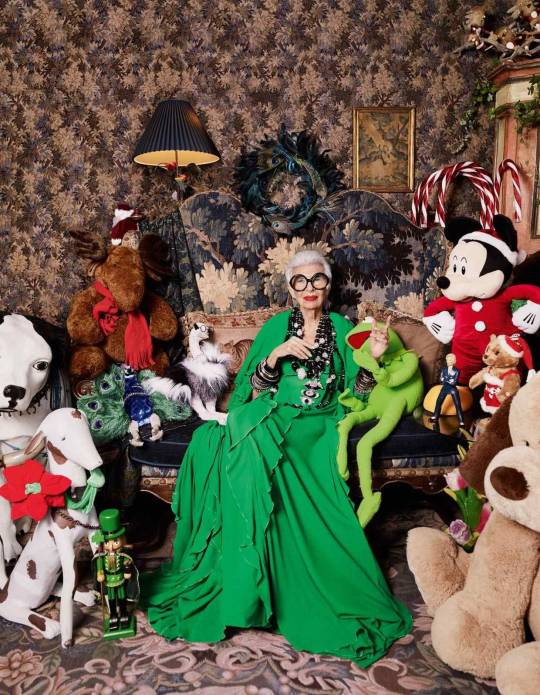

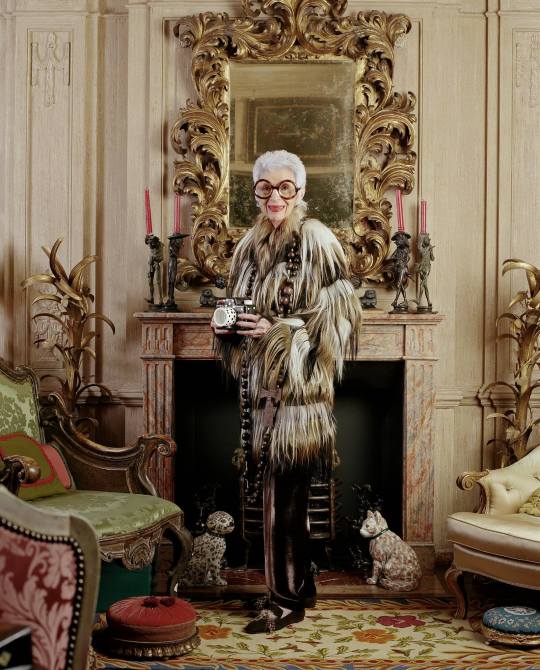
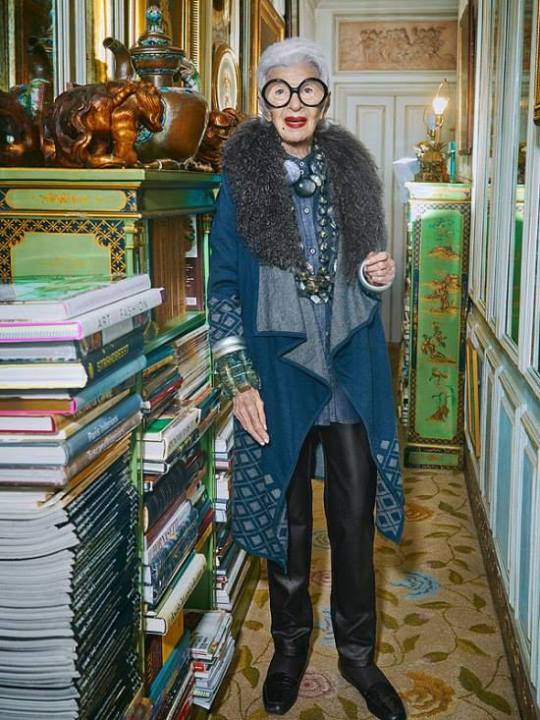




Iris Barrel Apfel, Decorator and Fashion Stylist
(August 29, 1921 – March 1, 2024)
Ms. Apfel was one of the most vivacious personalities in the worlds of fashion, textiles, and interior design, she has cultivated a personal style that is both witty and exuberantly idiosyncratic.
Her originality was typically revealed in her mixing of high and low fashions—Dior haute couture with flea market finds, nineteenth-century ecclesiastical vestments with Dolce & Gabbana lizard trousers.
With remarkable panache and discernment, she combines colors, textures, and patterns without regard to period, provenance, and, ultimately, aesthetic conventions. Paradoxically, her richly layered combinations—even at their most extreme and baroque—project a boldly graphic modernity.
Iris Barrel was born on Aug. 29, 1921, in Astoria, Queens, the only child of Samuel Barrel, who owned a glass and mirror business, and his Russian-born wife, Sadye, who owned a fashion boutique.
She studied art history at New York University, then qualified to teach and did so briefly in Wisconsin before fleeing back to New York to work on Women's Wear Daily, and for interior designer Elinor Johnson, decorating apartments for resale and honing her talent for sourcing rare items before opening her own design firm. She was also an assistant to illustrator Robert Goodman.
As a distinguished collector and authority on antique fabrics, Iris Apfel has consulted on numerous restoration projects that include work at the White House that spanned nine presidencies from Harry Truman to Bill Clinton.
Along with her husband, Carl, she founded Old World Weavers, an international textile manufacturing company and ran it until they retired in 1992. The Apfels specialized in the reproduction of fabrics from the 17th, 18th, and 19th centuries, and traveled to Europe twice a year in search of textiles they could not source in the United States.
The Metropolitan Museum of Art’s Costume Institute assembled 82 ensembles and 300 accessories from her personal collection in 2005 in a show about her called “Rara Avis”.
Almost overnight, Ms. Apfel became an international celebrity of pop fashion.
Ms. Apfel was seen in a television commercial for the French car DS 3, became the face of the Australian fashion brand Blue Illusion, and began a collaboration with the start-up WiseWear. A year later, Mattel created a one-of-a-kind Barbie doll in her image. Last year, she appeared in a beauty campaign for makeup with Ciaté London.
Six years after the Met show she started her fashion line "Rara Avis" with the Home Shopping Network.
She was cover girl of Dazed and Confused, among many other publications, window display artist at Bergdorf Goodman, designer and design consultant, then signed to IMG in 2019 as a model at age 97.
Ms. Iris Apfel became a visiting professor at the University of Texas at Austin in its Division of Textiles and Apparel, teaching about imagination, craft and tangible pleasures in a world of images.
In 2018, she published “Iris Apfel: Accidental Icon,” an autobiographical collection of musings, anecdotes and observations on life and style.
Ms. Apfel’s apartments in New York and Palm Beach were full of furnishings and tchotchkes that might have come from a Luis Buñuel film: porcelain cats, plush toys, statuary, ornate vases, gilt mirrors, fake fruit, stuffed parrots, paintings by Velázquez and Jean-Baptiste Greuze, a mannequin on an ostrich.
The Museum of Lifestyle & Fashion History in Boynton Beach, Florida, is designing a building that will house a dedicated gallery of Ms. Apfel's clothes, accessories, and furnishings.
Ms. Apfel’s work had a universal quality, It’s was a trend.
Rest in Power !
#art#design#fashion#icon#rip#iris apfel#luxury lifestyle#rip riris apfel#style icon#iconic#trend#rare avis#women's fashion#walking closet#muse#themet#style#history#renaissance#baroque#greta garbo#dior#chanel#montana#fendi#jewellery#high fashion#fantasy#women history month
183 notes
·
View notes
Text
reading more about atomic gardening and this is so much fun. to read about that is. it also seems fun to do, but. you know. anyway:
"The story of these citizen-pioneers of mutagenesis (the technical term for creating genetic change through the application of chemical, physical, and biological agents) is full of fantastic details, from Muriel Howorth’s propagandising ballet-mime, Isotopia, which involved a cast of Knowledge, Electron, Proton, Neutron, Rat, and Cow, as well as a working geiger counter, to Tennessee-based atomic entrepreneur C.J. Speas irradiating trays of seedlings into his backyard bunker.

IMAGE: C.J. Speas giving a tour of his radioactive bunker to high school students, photo by Grey Villet for Life, via Pruned.
Perhaps the most bizarre detail in the interview, however, is the news that these gamma gardens are still in operation, relatively unchanged in design since the 50s, in the grounds of national laboratories today. Their circular form, which, as Johnson notes, bears more than a passing resemblance to the atomic danger symbol, “was simply based upon the need to arrange the plants in concentric circles around the radiation source which stood like a totem in the center of the field.”
It was basically a slug of radioactive material within a pole; when workers needed to enter the field it was lowered below ground into a lead lined chamber. There were a series of fences and alarms to keep people from entering the field when the source was above ground. The amount of radiation received by the plants naturally varied according to how close they were to the pole. So usually a single variety would be arranged as a ‘wedge’ leading away from the pole, so that the effects of a range of radiation levels could be evaluated. Most of the plants close to the pole simply died. A little further away, they would be so genetically altered that they were riddled with tumors and other growth abnormalities. It was generally the rows where the plants ‘looked’ normal, but still had genetic alterations, that were of the most interest, that were ‘just right’ as far as mutation breeding was concerned!
Over at GOOD, Peter Smith recently described a similar layout at the still-active Institute of Radiation Breeding, in Hitachiohmiya, Japan, which has “has a 88.8 Terabecquerel Cobalt-60 source, ringed by a 3,608-foot radius Gamma field (the world’s largest), and a 28-foot high shield dike around the perimeter.”

IMAGE: A gamma garden at Brookhaven National Labs, New York, c. 1958; image provided by Paige Johnson, via Pruned.
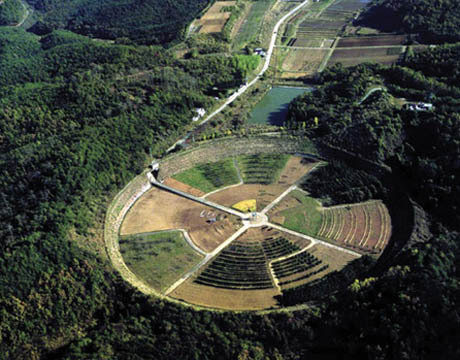
IMAGE: Aerial view of the Institute of Radiation Breeding, Hitachiohmiya, Japan.
As it turns out, far from being a fantastic fossil from the future that never was, along with jetpacks and flying cars, atomic gardening is alive and well today. According to a 2007 New York Times story, which quotes Dr. Pierre Lagoda, head of plant breeding and genetics at the International Atomic Energy Agency, radiation breeding is actually experiencing a renaissance, due to the introduction of “new methods that speed up the identification of mutants.”
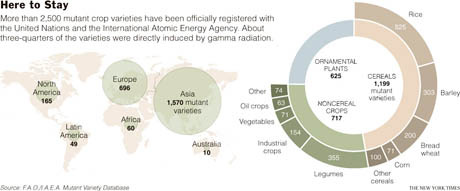
IMAGE: Mutant crop varieties mapped by The New York Times.
What’s more, the Times adds, nearly 2,000 gamma radiation-induced mutant crop varieties have been registered around the world, including Calrose 76, a dwarf varietal that accounts for about half the rice grown in California, and the popular Star Ruby and Rio Red grapefruits, whose deep colour is a mutation produced through radiation breeding in the 1970s. Similarly, Johnson tells Pruned that “most of the global production of mint oil,” with an annual market value estimated at $930 million, is extracted from the “wilt-resistant ‘Todd’s Mitcham’ cultivar, a product of thermal neutron irradiation.” She adds that “the exact nature of the genetic changes that cause it to be wilt-resistant remain unknown.”

IMAGE: “Pierre Lagoda, the head of plant breeding and genetics at the International Atomic Energy Agency, showing mutated plants at a greenhouse in Austria,” photo by Herwig Prammer for The New York Times."
37 notes
·
View notes
Text




Snippet of Euclid Mission’s Cosmic Atlas Released by ESA
With contributions from NASA, the mission will map a third of the sky in order to study a cosmic mystery called dark energy.
ESA (the European Space Agency) has released a new, 208-gigapixel mosaic of images taken by Euclid, a mission with NASA contributions that launched in 2023 to study why the universe is expanding at an accelerating rate. Astronomers use the term “dark energy” in reference to the unknown cause of this accelerated expansion.
The new images were released at the International Astronautical Congress in Milan on Oct. 15.
The mosaic contains 260 observations in visible and infrared light made between March 25 and April 8 of this year. In just two weeks, Euclid covered 132 square degrees of the southern sky — more than 500 times the area of the sky covered by a full Moon.
The mosaic accounts for 1% of the wide survey Euclid will conduct over six years. During this survey, the telescope observes the shapes, distances, and motions of billions of galaxies out to a distance of more than 10 billion light-years. By doing this, it will create the largest 3D cosmic map ever made.
This first piece of the map already contains around 100 million stars and galaxies. Some 14 million of these galaxies could be used by Euclid to study the hidden influence of dark energy on the universe.
“We have already seen beautiful, high-resolution images of individual objects and groups of objects from Euclid. This new image finally gives us a taste of the enormity of the area of sky Euclid will cover, which will enable us to take detailed measurements of billions of galaxies,” said Jason Rhodes, an observational cosmologist at NASA’s Jet Propulsion Laboratory in Southern California who is the U.S. science lead for Euclid and principal investigator for NASA’s Euclid dark energy science team.
Galaxies Galore
Even though this patch of space shows only 1% of Euclid’s total survey area, the spacecraft’s sensitive cameras captured an incredible number of objects in great detail. Enlarging the image by a factor of 600 reveals the intricate structure of a spiral galaxy in galaxy cluster Abell 3381, 470 million light-years away.
“What really strikes me about these new images is the tremendous range in physical scale,” said JPL’s Mike Seiffert, project scientist for the NASA contribution to Euclid. “The images capture detail from clusters of stars near an individual galaxy to some of the largest structures in the universe. We are beginning to see the first hints of what the full Euclid data will look like when it reaches the completion of the prime survey.”
Visble as well are clouds of gas and dust located between the stars in our own galaxy. Sometimes called “galactic cirrus” because they look like cirrus clouds at Earth, these clouds can be observed by Euclid’s visible-light camera because they reflect visible light from the Milky Way.
The mosaic released today is taste of what’s to come from Euclid. The mission plans to release 53 square degrees of the Euclid survey, including a preview of the Euclid Deep Field areas, in March 2025 and to release its first year of cosmology data in 2026.
NASA’s forthcoming Nancy Grace Roman mission will also study dark energy — in ways that are complementary to Euclid. Mission planners will use Euclid’s findings to inform Roman’s dark energy work. Scheduled to launch by May 2027, Roman will study a smaller section of sky than Euclid but will provide higher-resolution images of millions of galaxies and peer deeper into the universe’s past, providing complementary information. In addition, Roman will survey nearby galaxies, find and investigate planets throughout our galaxy, study objects on the outskirts of our solar system, and more.
More About Euclid
Euclid is a European mission, built and operated by ESA, with contributions from NASA. The Euclid Consortium — consisting of more than 2,000 scientists from 300 institutes in 15 European countries, the United States, Canada, and Japan — is responsible for providing the scientific instruments and scientific data analysis. ESA selected Thales Alenia Space as prime contractor for the construction of the satellite and its service module, with Airbus Defence and Space chosen to develop the payload module, including the telescope. Euclid is a medium-class mission in ESA’s Cosmic Vision Programme.
Three NASA-supported science teams contribute to the Euclid mission. In addition to designing and fabricating the sensor-chip electronics for Euclid’s Near Infrared Spectrometer and Photometer (NISP) instrument, JPL led the procurement and delivery of the NISP detectors as well. Those detectors, along with the sensor chip electronics, were tested at NASA’s Detector Characterization Lab at Goddard Space Flight Center in Greenbelt, Maryland. The Euclid NASA Science Center at IPAC (ENSCI), at Caltech in Pasadena, California, will archive the science data and support U.S.-based science investigations. JPL is a division of Caltech.
TOP IMAGE: This mosaic from ESA’s Euclid space telescope contains 260 observations in visible and infrared light. It covers 132 square degrees, or more than 500 times the area of the full Moon, and is 208 gigapixels. This is 1% of the wide survey that Euclid will capture during its six-year mission. Credit: ESA/Euclid/Euclid Consortium/NASA, CEA Paris-Saclay, image processing by J.-C. Cuillandre, E. Bertin, G. Anselmi. CC BY-SA 3.0 IGO
CENTRE IMAGE: This section of the Euclid mosaic is zoomed in 36 times, revealing the core of galaxy cluster Abell 3381, 470 million light-years from Earth. The image, made using both visible and infrared light, shows galaxies of different shapes and sizes, includin… Credit: ESA/Euclid/Euclid Consortium/NASA, CEA Paris-Saclay, image processing by J.-C. Cuillandre, E. Bertin, G. Anselmi. CC BY-SA 3.0 IGO
LOWER IMAGE: This image shows an area of the Euclid mosaic zoomed in 150 times. The combination of visible and infrared light reveals galaxies that are interacting with each other in cluster Abell 3381, 470 million light-years away from Earth. Credit: ESA/Euclid/Euclid Consortium/NASA, CEA Paris-Saclay, image processing by J.-C. Cuillandre, E. Bertin, G. Anselmi. CC BY-SA 3.0 IGO
BOTTOM IMAGE: The location and actual size of the newly released Euclid mosaic is highlighted in yellow on a map of the entire sky captured by ESA’s Planck mission and a star map from ESA’s Gaia mission. Credit: ESA/Euclid/Euclid Consortium/NASA; ESA/Gaia/DPAC; ESA and the Planck Collaboration. CC BY-SA 3.0 IGO
youtube

This section of the Euclid mosaic is zoomed in 600 times. A single spiral galaxy is visible in great detail within cluster Abell 3381, 470 million light-years away from us. Data from both the visible and infrared light instruments on Euclid are included. Credit: ESA/Euclid/Euclid Consortium/NASA, CEA Paris-Saclay, image processing by J.-C. Cuillandre, E. Bertin, G. Anselmi. CC BY-SA 3.0 IGO
13 notes
·
View notes
Note
Ria is cool! Is she an oc or an existing character? Also what’s her lore? :)
Thank you so much for your kind words and interest! (I was extremely happy to receive your question though it took me a while to prepare the answer... sorry for that!! ;_; )
(I hope the quality of the image is acceptable for comfortable reading but just in case I'll copy the text in the very end of the post )

Ria is an original character inspired mostly by asian popular culture origins: games/anime/music (e.g., FGO, Honkai Impact 3rd, Madoka Magica, OkameP's songs) and world mythology/philosophy/history, as well as classical literature/music/paintings (e.g., characters like the Count of Monte Cristo and Irene Adler in particular) As for Marvel lore, I was hugely expired by Matt's story and Illyana Rasputina's story Overall, the most charming ideas I personally find in Ria are:
Healing through art that captures the beauty of the world around us.
A human's yearning to find warmth, a sense of home, and connection with others.
The duality within humans—their ability to embody kindness and tenderness while making harsh (and even cruel) decisions for a greater purpose.
________________________________________________________
The text from the image: REAL NAME: Angelina Mikhailovna Sokolova (birth name), Alleria Betskaya (current legal name) OCCUPATION: Senior ML Researcher at VECTOR Inc., RnD Department; VECTOR’S co-founder and CTO (classified) LEGAL STATUS: Deceased (Angelina), Finnish citizen (Alleria) OTHER ALIASES: Angel\Princess (coined by Matt Murdock), Ri PLACE OF BIRTH: Saint Petersburg, Russia MARITAL\RELATIONSHIP STATUS: Single KNOWN RELATIVES: Maria Yuriyevna Sokolova (mother, deceased), Mikhail Alexandrovich Sokolov (father), Victoria Betskaya (aunt, deceased) GROUP AFFILIATION: VECTOR Inc., The Collegium (former) BASE OF OPERATIONS: Worldwide, the Primordial Realm (former)
HISTORY: Ria's childhood was blissfully ignorant of her family's true nature until she and her mother were kidnapped by a rival gang targeting her father, a notorious crime lord in Saint Petersburg. This event changed Ria’s life dramatically. Though the traumatic incident is mostly a blur, she vividly recalls her mother being shot and her last words: "Inherit my eyes." The next thing she remembers is her father's men arriving to find her standing amidst a chaotic bloodbath, with all the rival gang members dead around her. To ensure Ria’s safety and future, her father transferred the guardianship to Ria’s aunt, who ran an elite girls' boarding school. This institution, rooted in the Russian Empire and relocated to Finland post-October Revolution, trained individuals to influence high society from behind the scenes. A harsh upbringing with rigorous training and high expectations instilled in Ria an unwavering commitment to her principles, driven by the doctrine that the end justifies the means. This environment has also fostered a sense of perfectionism and a hidden feeling of inadequacy, well-covered by the perfect facade expected in high society. Ria's excellent education allowed her to successfully enroll in Oxford's School of International Relations, Diplomacy, and Law. Moving to the UK, she became one of the most diligent students while finally enjoying a normal life with friends and hobbies. However, after two years of studying, her aunt urgently called her back home.
Over these two years, Ria's aunt's mind deteriorated, leading to delusions. Mistaking Ria for her mother, Maria, she attacked her in a jealous rage, leaving Ria's body in a coma. Ria’s consciousness was transported to the Primordial Realm, where she survived against dangerous entities, developed new abilities, and joined the Collegium, a group fighting the Corruption that turns beings into monsters. There, she formed a deep bond with Haruko, a medic from a war-torn future. While they eventually found a way to return Ria to the human world and even founded a tech company “Vector”, tragedy struck when Haruko sacrificed herself to save Ria from a primordial entity consumed by Corruption. As the Collegium members began succumbing to Corruption, losing their humanity and being erased from existence, Ria discovered that the Judge, their leader, had orchestrated these betrayals. In the end, she executed the Judge and took his place, leading a centuries-long purge of the Primordial Realm. To prevent herself from falling to Corruption, she sealed herself within her own consciousness, using the isolation to recover and reflect on the devastating events, including Haruko's sacrifice. Upon returning to the human world after a 10000 mental years long exile, where only three months had passed, Ria moved to New York to reclaim her company and finish her friends' unfinished business, trying to retire from her heroic past. But her quiet life was disrupted by a subway mob raid, where Ria stepped in to help Matt Murdock, a blind lawyer, showing him a rare kindness he had never known.
HEIGHT: 160 CM WEIGHT: 47 KG EYES: VIOLET (WEARS GREEN LENSES) HAIR: DARK (DEEP MAGENTA) SKILLS\TALENTS: Ria has extensive knowledge in humanities and technical subjects. She also excels in fine arts (drawing, piano, and violin), and speaks multiple languages. Her strong analytical skills and inductive reasoning enhance her observation abilities, while genetic recombination boosts her cognitive capacities, including nervous system resilience and information processing speed. WEAPONS\EQUIPMENT: Despite her enhanced sight, which could rival Hawkeye's precision and Bullseye's deadliness, Ria is a civilian who does not wield any weapons. Due to a heart condition, she lacks endurance and physical strength, and her childhood trauma makes her uncomfortable with guns and sensitive to blood. Instead, she values information and knowledge as her greatest assets — her iPhone and MacBook are her essential tools and her greatest shield. FUN FACT: Ria has a deep appreciation for the arts, with a particular passion for Gesamtkunstwerk, or total art forms like theater. Unfortunately, her favorite ballet, "Swan Lake," which she saw in New York, deeply disappointed Ria due to Odile's overly flashy and inaccurate portrayal.
5 notes
·
View notes
Text
Maa Saraswati , the goddess of wisdom, embodiment of knowledge, arts, and learning in Hinduism, holds a significant place in the lives of millions of people. She represents the ideals of purity, intellectual growth, and spiritual enlightenment.
* Goddess of Wisdom and Knowledge: Maa Saraswati embodies wisdom and intellect. Worshipping her is believed to bless individuals with knowledge, clarity of thought, and the ability to excel in academic and professional pursuits. She inspires creativity and logical thinking.
* Encourages Learning and Education: Maa Saraswati is revered by students, scholars, and teachers alike. Her blessings are thought to enhance one's ability to learn and grasp new concepts. This is why Saraswati Puja, especially on Vasant Panchami, is celebrated with great enthusiasm in schools, colleges, and homes.
* Promotes Creativity and Arts: Maa Saraswati is also associated with music, arts, and culture. Artists, musicians, and dancers seek her blessings for inspiration and skill in their respective crafts. The goddess holds a veena , symbolizing the importance of artistic expression.
* Symbol of Purity and Peace: Maa Saraswati is often depicted in white attire, symbolizing purity and peace. She represents the purity of thought, speech, and action, guiding individuals toward a balanced and harmonious life.
*Spiritual Enlightenment: Apart from knowledge and intellect, Maa saraswati is also associated with spiritual growth. She helps individuals on their path of self-realization and enlightenment, allowing them to gain inner peace and wisdom beyond material knowledge.
In essence, Maa Saraswati's presence in our lives nurtures intellectual, artistic, and spiritual growth, making her an essential figure in the pursuit of wisdom and enlightenment.
As per Hindu tradition, Maa Saraswati was the first to articulate speech and therefore, she's also regarded as the goddess of poetry. In numerous textbooks, she's associated with the creation and preservation of the Vedas, the sacred Holy Writ of Hinduism.
* Carnivals and Worship *
Maa Saraswati Puja is a major Hindu jubilee devoted to her, celebrated especially in India, Nepal, and Bangladesh. It falls on the fifth day of the jubilee of Vasant Panchami, which marks the appearance of spring. On this day, addicts place their books, musical instruments, and tools for work near their hero or image, seeking her blessings for knowledge and success. It's customary to refrain from working or studying on this day and rather concentrate on prayer and devotion to the goddess.
Maa Saraswati's deification is significant in educational institutions, particularly in India, where scholars and preceptors likewise seek her blessings to excel in their academic and professional hobbies.
* Philosophical Significance *
Maa Saraswati isn't just the goddess of worldly knowledge but also of spiritual wisdom. Her blessings are believed to help individuals gain understanding, internal clarity, and enlightenment. Maa Saraswati represents the union of knowledge and creativity, showing that intellect and cultural expression aren't mutually exclusive but connected, essential for a balanced life.
* Cultural Impact *
In addition to her religious significance, Maa Saraswati plays an important part in artistic and educational conditioning. Her influence extends beyond Hinduism, with colorful seminaries, universities, music institutions, and artistic associations naming themselves after her. Saraswati's image inspires scholars, musicians, and artists to strive for excellence and creativity in their trials.
In summary, Maa Saraswati is a symbol of chastity, wisdom, and enlightenment, worshipped by millions for her godly blessings in knowledge and creativity.
Pehlaplatform is a unique online space dedicated to showcasing and promoting beautiful handicrafts from talented artisans. The website serves as a platform for showcasing a wide range of handcrafted products, from traditional artwork and home décor .
Pehlaplatform prides itself on supporting local artisans, helping them gain exposure, and fostering a deeper appreciation for traditional craftsmanship.
The site not only offers exquisite, handmade items for sale but also educates visitors about the stories and cultural significance behind each product. Every item available on Pehlaplatform is a testament to the skills, creativity, and heritage of the artisans who make them, ensuring that each purchase is a meaningful one.
Pehlaplatform's user-friendly interface allows customers to explore various categories of handicrafts, discover new artists, and make purchases easily. The platform also strives to create a community of makers and buyers who share a passion for supporting sustainable, ethical, and culturally rich products.
Pehlaplatform understands the significance of maa Saraswati very well. That is why we have made many types of maa Saraswati idols that express your feelings. Pehlaplatform has made each idol with a lot of love and dedication.
Whether you're looking for unique home decorations, God idols, and unique gifts Pehlaplatform offers a diverse selection of one-of-a-kind items that tell a story with every thread and design.
Explore our diverse collection today and discover the beauty of handcrafted creations that tell a story. At PehlaPlatform, we believe that every piece has a meaning and a journey. join us in supporting artisans and celebrating the beauty of handmade craftsmanship.
Thank you for supporting handmade art!
#911 abc#agatha all along#agatha harkness#anya mouthwashing#architecture#artists on tumblr#batman#bucktommy#captain curly#cats of tumblr
2 notes
·
View notes
Text
Are Helvetic Clinics in Hungary the Future of Affordable Dental Implants?

When it comes to dental restoration, dental implants are considered one of the most effective and long-lasting solutions. For those seeking high-quality dental care at an affordable price, dental implants Hungary Helvetic Clinics offer a compelling combination of cost savings, state-of-the-art technology, and experienced professionals. If you’re considering dental tourism or simply want top-tier dental work without breaking the bank, read on to discover why Helvetic Clinics in Hungary may be your ideal choice.
Why Choose Dental Implants?
Dental implants are titanium posts surgically inserted into the jawbone, acting as artificial roots to support crowns, bridges, or dentures. Unlike temporary solutions, implants offer permanence, durability, and functionality close to natural teeth. They prevent bone loss, enhance facial aesthetics, and improve chewing efficiency. However, in many Western countries, dental implants can cost several thousand dollars per tooth. This is where dental implants Hungary Helvetic Clinics shine, offering similar – if not superior – standards of care at a fraction of the price.
Why Hungary for Dental Implants?
Hungary, especially its capital Budapest, has earned a global reputation as a hub for dental tourism. Known for its well-trained dental professionals and modern clinics, Hungary attracts thousands of patients from the UK, Germany, Ireland, and even the US every year. The affordability doesn’t come at the expense of quality. Many Hungarian dentists receive their training from prestigious European institutions, and the dental industry is tightly regulated. Among the top clinics offering these services, dental implants Hungary Helvetic Clinics stand out for their exceptional service, modern facilities, and commitment to patient satisfaction.
Helvetic Clinics – Setting a New Standard
Helvetic Clinics is located in Budapest and has become synonymous with premium dental tourism. The clinic is part of a Swiss-owned network, known for adhering to the highest European standards in hygiene, equipment, and training.
Patients visiting dental implants Hungary Helvetic Clinics can expect:
ISO-certified facilities
English-speaking staff and dentists
Personalized treatment plans
Competitive pricing with no hidden costs
State-of-the-art technology including 3D imaging and digital impressions
These features ensure that international patients receive the same level of care (or better) than they would at home, all while enjoying significant savings and the opportunity to explore a beautiful European city.
Treatment Process at Helvetic Clinics
At dental implants Hungary Helvetic Clinics, the implant process is thorough and tailored to each patient’s needs. Here’s what to expect:
Initial Consultation: A dentist evaluates your oral health, reviews X-rays, and performs a 3D scan to determine if you’re a suitable candidate.
Treatment Plan: You receive a clear and transparent plan outlining the number of implants, materials used, procedures involved, and cost breakdown.
Implant Placement: The implants are placed under local anesthesia, often requiring a healing period of 3 to 6 months for osseointegration.
Final Restoration: Once the implant has fused with the bone, crowns or bridges are attached, completing your smile transformation.
Some patients may require bone grafting or sinus lifts, which are also expertly handled by Helvetic Clinics’ experienced oral surgeons.
Cost Advantage of Helvetic Clinics
One of the biggest reasons to consider dental implants Hungary Helvetic Clinics is cost. Compared to UK or US clinics where an implant might cost upwards of €3,000, Helvetic Clinics offer implants starting from approximately €900. Even when you factor in travel and accommodation, the overall cost remains significantly lower, especially for those needing multiple implants. The clinic also offers accommodation packages in their own in-house hotel, ensuring convenience and further cost savings.
Real Stories from International Patients
Thousands of satisfied patients have chosen dental implants Hungary Helvetic Clinics, citing professionalism, care quality, and affordability as standout features. Testimonials often highlight the stress-free experience, from airport transfers to post-treatment follow-ups. Many patients are surprised by the luxurious clinic environment, modern equipment, and attention to detail – far exceeding expectations for medical tourism.
Is It Safe?
Understandably, patients may worry about traveling abroad for medical care. Helvetic Clinics address these concerns with:
Transparent communication
Strict adherence to EU medical standards
Multilingual staff
Long-term guarantees on dental implants
Your dental health is in expert hands when you choose dental implants Hungary Helvetic Clinics.
FAQs
Q1: Are dental implants at Helvetic Clinics really cheaper than in my home country?Ans. Yes, even including flights and hotel stays, the total cost at dental implants Hungary Helvetic Clinics is often 50–70% less than what you would pay in Western Europe or North America.
Q2: How long does the treatment take?Ans. Implant treatments typically require two visits: the first for implant placement and the second (after 3–6 months) for crown installation. Some cases can be expedited with same-day solutions depending on bone health.
Q3: Is Helvetic Clinics certified?Ans. Yes, Helvetic Clinics in Hungary are ISO 9001 certified, ensuring strict quality management and hygiene standards.
Q4: Can I get support after returning home?Ans. Yes, the clinic offers guarantees and provides remote follow-up consultations to ensure your implants are performing well.
Q5: Do I need to speak Hungarian?Ans. Not at all. The staff at dental implants Hungary Helvetic Clinics are fluent in English, and often in French and German as well, making communication easy.
Final Thoughts
If you're exploring options for dental implants, dental implants Hungary Helvetic Clinics should be at the top of your list. Combining Swiss precision with Hungarian affordability, the clinic offers world-class care without the inflated price tag. By choosing Helvetic Clinics, you not only invest in a healthier smile but also get the chance to experience one of Europe’s most beautiful cities, all while saving thousands on your dental care.Whether you need a single implant or a full mouth restoration, dental implants Hungary Helvetic Clinics provide a smart, safe, and cost-effective solution. Book your consultation today and take the first step toward restoring your smile with confidence.
0 notes
Text
References
Brown, Jane Hollier. “21 Body-Shaming Magazine Covers That Prove Women Just Can’t Win.” BuzzFeed Community, BuzzFeed, 27 Mar. 2015, www.buzzfeed.com/whatjanedid/21-of-the-most-offensive-gossip-magazine-covers-15zo9?epik=dj0yJnU9bmNGUk9XM193Nmc5cWo5TG9aM3Jlc01NWTM2b0xxa2kmcD0wJm49Sk83QzhOMHBqUk5JandPVno3TlBIZyZ0PUFBQUFBR2d0Ung0.
Coy-Dibley, Isabelle. "‘Digitised Dysmorphia’ of the Female Body: The Re/Disfigurement of the Image." Palgrave Communications, vol. 2, 2016, doi:10.1057/palcomms.2016.40.
French, Mandy. “Beauty Standards and Mental Health: The Connection and More.” Edited by Bethany Juby, Medical News Today, MediLexicon International, 1 May 2024, www.medicalnewstoday.com/articles/beauty-standards-and-mental-health.
Kiner, Mikaela. “It’s Time to Break the Cycle of Female Rivalry.” Harvard Business Review, Harvard Business Review, 14 Apr. 2020, hbr.org/2020/04/its-time-to-break-the-cycle-of-female-rivalry.
Lang, Cady. “Not Even the Kardashians Can Keep Up With Their Unrealistic Beauty Standards.” Time, Time, 28 July 2023, time.com/6298911/kardashians-kylie-jenner-boob-job-beauty-standards/.
Oakes, Kelly. “The Complicated Truth about Social Media and Body Image.” BBC News, BBC, 24 Feb. 2022, www.bbc.com/future/article/20190311-how-social-media-affects-body-image.
“Perception Is Reality: The Looking-Glass Self.” Perception Is Reality: The Looking-Glass Self | Lesley University, lesley.edu/article/perception-is-reality-the-looking-glass-self. Accessed 21 May 2025.
Sportsman, Kelsey. SOCI 112: Week 5: Agents and Variations in Gender Rules, uploaded by Sportsman 10 Feb. 2025, https://msjc.instructure.com/courses/44067/pages/agents-and-variations-in-gender-rules?module_item_id=4257000
Wade, Lisa, and Myra Marx Ferree. Gender: Ideas, Interactions, Institutions. New York: W. W. Norton & Company, 2018.
Yetsenga, Rhiannon, et al. “The Economic and Social Costs of Body Dissatisfaction and Appearance-Based Discrimination in the United States.” Eating Disorders, vol. 32, no. 6, Nov. 2024, pp. 572–602. EBSCOhost, https://doi-org.msjc.idm.oclc.org/10.1080/10640266.2024.2328461.
0 notes
Text
0 notes
Text


The images above are from David Hockney’s 2023 exhibition of iPad paintings, 20 Flowers and Some Bigger Pictures, at Pace Gallery. Hockney discusses these works in this essay from the show’s catalogue.
From Pace about this exhibition-
This exhibition will present a distinct series of editioned and signed inkjet prints including five landscapes, twenty floral still lifes, and a composite of three iPad paintings depicting a bouquet of gladioli. These works reveal the presence of Hockney’s hand as well as his deliberate technique for drafting larger-than-life compositions on the iPad. While Hockney’s flowers capture the fleeting stillness of his subjects, his immersive landscapes establish the vastness of his rural surroundings. Whether bound to a single moment in time or created from multiple planes of vision, Hockney’s distinctive sense of time and space draws from art historical examples ranging from the Bayeux Tapestry and seventeenth-century Chinese scrolls to the still lifes of Henri Matisse.
A cornerstone of the series, Hockney’s landscapes call upon his observations of the changing of seasons. In each of his gridded picture planes, Hockney reimagines the Normandy countryside with bright colors, abstracted forms, and impossible angles of otherwise traditional outdoor scenes. Placing his focus on themes of renewal and rebirth, the resulting body of work reflects the pastoral nostalgia and beauty of the natural world.
First reproduced by the German newspaper, Die Welt, and later debuted at Musée Matisse in Nice, Hockney’s series of twenty flower iPad paintings captures various arrangements of blooms set against a backdrop of gingham tablecloths and burgundy walls. “I was just sitting at the table in our house, and I caught sight of some flowers in a vase on the table,” Hockney explains. “A few days later I started another from the same position with the same ceramic vase. This took longer to do. I then realized if I put the flowers in a glass vase the sun would catch the water, and painting glass would be a more interesting thing to do. So then I was off.” Though attributes vary in each work, such as the species of flower, type of vase, and the color of the tablecloth, consistent elements across this series allow viewers to admire Hockney’s technique and dedication to his subject. Capturing a spectrum of floral compositions with contrasting tones and textures, Hockney displays his propensity for balancing the central artistic elements of line, color, and perspective.
At the center of the exhibition, Hockney debuts his latest large-scale photographic drawing, 25th June 2022, Looking at the Flowers (Framed). Within the composition, Hockney is depicted twice – once on the right side of the scene, and once on the left – sitting in an armchair and looking upon his twenty flower still lifes displayed salon-style on a navy-blue wall. “This is photographic but is in no way an ordinary photograph,” Hockney describes. “I had been doing what I called photographic drawings, giving a much more 3D effect. This is because you have to look at these through time (unlike an ordinary photograph which you see all at once).” From a series of individual photographs, Hockney constructs a seamless panorama that defies the natural parameters of time and space. The photographic drawing pulls viewers into a self-referential world that is at once familiar and entirely new. “Most people thought the photograph was the ultimate depiction of reality, didn’t they? People thought, This is it, this is the end of it. Which it’s not. And I’m very certain it’s not, but not many people think the way I do.”
Recently Hockney was invited to take over the entire building of the Fondation Louis Vuitton art museum in Paris for David Hockney 25. The exhibition includes- “more than 400 of his works (from 1955 to 2025) including paintings from international, institutional, and private collections, as well as works from the artist’s own studio and Foundation. There are works in a variety of media including oil and acrylic painting, ink, pencil and charcoal drawing, digital art (works on iPhone, iPad, photographic drawings…) and immersive video installations”. The core of the exhibition concentrates on his work from the past 25 years .
That show is on view until 8/31/25.
#David Hockney#Pace Gallery NYC#Fondation Louis Vuitton#Pace Gallery#Chelsea Art Galleries#Chelsea Art Shows#Paris Art Shows#Digital Art#Film and Video#NYC Art Shows#Painting#Video#Paris#Photographic Drawing#Photography#TBT
1 note
·
View note
Text
📍 References
Erleia. 2024. “Why Diversity and Inclusion Remain Important in Beauty Marketing.” Forbes, February 19. https://www.forbes.com/sites/forbeseq/2024/02/15/why-diversity-and-inclusion-remain-important-in-beauty-marketing/
Harvard T.H. Chan School of Public Health. 2024. “The Real Cost of Beauty Ideals.” Harvard T.H. Chan School of Public Health, October 30. https://hsph.harvard.edu/research/eating-disorders-striped/research-reports/real-cost-beauty-ideals/
Mady, Samia, Dipayan Biswas, Christian A. Dadzie, Ronald Paul Hill, and Rajesh Paul. 2023. “A Whiter Shade of Pale: Whiteness, Female Beauty Standards, and Ethical Engagement Across Three Cultures.” Journal of International Marketing 31(1):69–89. https://doi.org/10.1177/1069031X221112642
National Institutes of Health (NIH). 2019. “The Role of Media in Body Image Perception.” National Center for Biotechnology Information (PMC). https://pmc.ncbi.nlm.nih.gov/articles/PMC6861923/
Rajgor, Jecky. 2025. “The New Definition of Beauty: How Social Media Is Changing the Standards of Attractiveness.” Medium, January 17. https://medium.com/practice-in-public/the-new-definition-of-beauty-how-social-media-is-changing-the-standards-of-attractiveness-f76c113d86b9
0 notes
Text
DLF The Dahlias | Luxury & Comfort in Gurgaon

Introduction
DLF The Dahlias, located in Sector 54 on Golf Course Road, Gurgaon, is an indicator of refined living crafted via DLF Ltd, India’s biggest publicly traded real estate developer. As one of the maximum substantial luxury launches by way of DLF, this project is designed to set new benchmarks within the realm of ultra-top class dwelling. With beautiful architecture, sophisticated interiors, and a curated lifestyle, The Dahlias guarantees exclusivity and grandeur in each rectangular foot.
Location Advantages
Strategically located on Golf Course Road, called Gurgaon’s Golden Mile, The Dahlias is surrounded by high-give up business hubs, luxurious lodges, satisfactory-eating restaurants, and upscale retail areas. Sector 54 enjoys outstanding civic infrastructure, making DLF The Dahlias Sector 54 Golf Course Road Gurgaon one of the maximum coveted residential destinations within the NCR. The location additionally boasts proximity to outstanding educational institutions and world-magnificence healthcare facilities.
Connectivity
The project enjoys seamless access to Golf Course Extension Road, MG Road, and the Delhi-Gurgaon Expressway. The Sector 54 Rapid Metro Station is within walking distance, providing easy transit throughout Gurgaon and direct linkage to Cyber City and different business districts. IGI Airport is just a 30-minute pressure away.
Amenities
DLF The Dahlias Sector 54 Gurgaon brings an unparalleled life-style enjoy with ultra-modern-day services which include a grand clubhouse, brand new gym, spa and wellbeing region, infinity-area pool, multi-cause courts, and plush landscaped gardens. The community is built round comfort, privacy, and entertainment with international-magnificence concierge services.
Vaastu Shastra
The Dahlias integrate Vaastu-compliant architecture, ensuring spatial concord, tremendous energy, and nicely-being. DLF The Dahlias Sector 54 is designed to beautify herbal light, airflow, and energy alignment—contributing to a tranquil, balanced lifestyle.
Floor Plan & Master Plan
The project capabilities expansive 4BHK residences designed with meticulous attention to element. Homes consist of non-public lobbies, large balconies, and smart domestic automation systems. The master plan embraces open green spaces, water functions, and pedestrian-friendly pathways, fostering community and calm.
Conclusion
DLF The Dahlias isn’t only a residential deal; it’s an image of luxury, class, and status. With its high area, elite facilities, and DLF’s legacy of excellence, it redefines Gurgaon’s luxurious real estate landscape. For discerning homeowners who aspire to a lifestyle beyond the ordinary, The Dahlias is a rare and perfect choice.
#DLF The Dahlias#DLF The Dahlias Sector 54 Gurgaon#DLF The Dahlias Sector 54 Golf Course Road Gurgaon
0 notes
Text

Webb finds candidates for first young brown dwarfs outside the Milky Way
An international team of astronomers has used the NASA/ESA/CSA James Webb Space Telescope to detect the first rich population of brown dwarf candidates outside the Milky Way in the star cluster NGC 602.
Near the outskirts of the Small Magellanic Cloud, a satellite galaxy roughly 200 000 light-years from Earth, lies the young star cluster NGC 602. The local environment of this cluster is a close analogue of what existed in the early Universe, with very low abundances of elements heavier than hydrogen and helium. The existence of dark clouds of dense dust and the fact that the cluster is rich in ionised gas also suggest the presence of ongoing star formation processes. Together with its associated HII [1] region N90, which contains clouds of ionised atomic hydrogen, this cluster provides a valuable opportunity to examine star formation scenarios under dramatically different conditions from those in the solar neighbourhood.
An international team of astronomers, including Peter Zeidler, Elena Sabbi, Elena Manjavacas and Antonella Nota, used Webb to observe NGC 602 and they detected candidates for the first young brown dwarfs outside our Milky Way. “Only with the incredible sensitivity and spatial resolution in the correct wavelength regime is it possible to detect these objects at such great distances,” shared lead author Peter Zeidler of AURA/STScI for the European Space Agency. “This has never been possible before and also will remain impossible from the ground for the foreseeable future.”
Brown dwarfs are the more massive cousins of giant gas planets (typically ranging from roughly 13 to 75 Jupiter masses, and sometimes lower). They are free-floating, meaning that they are not gravitationally bound to a star as exoplanets are. However, some of them share characteristics with exoplanets, like their atmospheric composition and storm patterns. “Until now, we’ve known of about 3000 brown dwarfs, but they all live inside our own galaxy,” added team member Elena Manjavacas of AURA/STScI for the European Space Agency.
“This discovery highlights the power of using both Hubble and Webb to study young stellar clusters,” explained team member Antonella Nota, executive director of the International Space Science Institute in Switzerland and the previous Webb Project Scientist for ESA. “Hubble showed that NGC602 harbors very young low mass stars, but only with Webb we can finally see the extent and the significance of the substellar mass formation in this cluster. Hubble and Webb are an amazingly powerful telescope duo!”
“Our results fit very well with the theory that the mass distribution of bodies below the hydrogen burning limit is simply a continuation of the stellar distribution,” shared Zeidler. “It seems they form in the same way, they just don’t accrete enough mass to become a fully fledged star.”
The team’s data include a new image from Webb’s Near-InfraRed Camera (NIRCam) of NGC 602, which highlights the cluster stars, the young stellar objects, and the surrounding gas and dust ridges, as well as the gas and dust itself, while also showing the significant contamination by background galaxies and other stars in the Small Magellanic Cloud. These observations were made in April 2023.
“By studying the young metal-poor brown dwarfs newly discovered in NGC602, we are getting closer to unlocking the secrets of how stars and planets formed in the harsh conditions of the early Universe,“ added team member Elena Sabbi of NSF's NOIRLab, the University of Arizona, and the Space Telescope Science Institute.
“These are the first substellar objects outside the Milky Way” added Manjavacas. “We need to be ready for new ground-breaking discoveries in these new objects!”
These observations were made as part of the JWST GO programme #2662 (PI: P. Zeidler). The results have been published in The Astrophysical Journal.
Notes
[1] Some of the most beautiful extended objects that we can see are known as HII regions, also called diffuse or emission nebulae. They contain mostly ionised hydrogen and are found throughout the interstellar medium in the Milky Way and in other galaxies.
TOP IMAGE: Near the outskirts of the Small Magellanic Cloud, a satellite galaxy roughly 200 000 light-years from Earth, lies the young star cluster NGC 602, which is featured in this new image from the NASA/ESA/CSA James Webb Space Telescope. This image includes data from Webb’s NIRCam (Near-InfraRed Camera) and MIRI (Mid-InfraRed Instrument).The local environment of this cluster is a close analogue of what existed in the early Universe, with very low abundances of elements heavier than hydrogen and helium. The existence of dark clouds of dense dust and the fact that the cluster is rich in ionised gas also suggest the presence of ongoing star formation processes. This cluster provides a valuable opportunity to examine star formation scenarios under dramatically different conditions from those in the solar neighbourhood.An international team of astronomers, including Peter Zeidler, Elena Sabbi, and Antonella Nota, used Webb to observe NGC 602 and detected candidates for the first young brown dwarfs outside our Milky Way. [Image description: A star cluster is shown inside a large nebula of many-coloured gas and dust. The material forms dark ridges and peaks of gas and dust surrounding the cluster, lit on the inner side, while layers of diffuse, translucent clouds blanket over them. Around and within the gas, a huge number of distant galaxies can be seen, some quite large, as well as a few stars nearer to us which are very large and bright.]Credit: ESA/Webb, NASA & CSA, P. Zeidler, E. Sabbi, A. Nota, M. Zamani (ESA/Webb)
youtube
youtube
youtube
8 notes
·
View notes
Text
Conveying the weight of valor

Striking new Medal of Honor Museum gives form to courage and sacrifice of those commended within
I’m not sure any work of architecture has the capacity to bring Americans together right now, but in a different time the National Medal of Honor Museum might have been it.

An unapologetically bold work of modern design, the $300 million museum, which formally opened March 22 in Arlington’s entertainment district, serves as both a monument to and museum for those who have received the nation’s highest military award, conferred for “gallantry and intrepidity at the risk of his or her life above and beyond the call of duty.”
The building makes a dramatic impression, standing out from its larger and less distinguished stadium neighbors thanks to its defining gesture, a massive metal-clad block (200 feet square) that hovers some 40 feet above ground, intended as a metaphor for the psychological weight borne by Medal of Honor recipients.
From a distance, it carries an almost sublime force, its metal skin shifting from light to dark with the changing of conditions and the angle from which it is viewed.
That includes its appearance from the sky; the building’s metal cladding extends to a roof unencumbered by machinery so as to present a clean image to the blimps and drones that regularly cover events at the adjacent sports venues.
In its uncompromising assertion of abstract form, it stands as an emphatic rejoinder to those who would suggest that only classical architecture has the appropriate beauty, dignity and symbolic power to represent American values.

The design, at least in its general contours, is the work of the Uruguayan-born architect Rafael Viñoly, who died in 2023 during the project’s planning and execution.
It was carried out by his New York-based firm, Rafael Viñoly Architects, which continues in operation as a partnership.
The museum is representative of the high-tech aesthetic and structural daring that has characterized the firm’s work since Viñoly founded it in 1983, and that is best illustrated by its Tokyo International Forum of 1997, a conference and cultural center with a soaring, glass-roofed atrium.
Last year, it received the Twenty-Five Year Award of the American Institute of Architects, the highest honor the organization grants for a building.
For all its success, the firm has also been embroiled in a number of high-profile controversies.

Lawsuits alleging design and construction failures have plagued 432 Park Avenue, a nearly 1,400-foot-tall luxury tower in Manhattan.

Two of its buildings, 20 Fenchurch Street in London (better known as the Walkie Talkie) and the Vdara Hotel in Las Vegas, required measures to resolve reflection problems akin to those at Museum Tower in Dallas.

The firm won the Medal of Honor commission in 2020, beating out three firms for the project, thanks in no small measure to Viñoly’s dramatic presentation to the museum board.
Eschewing the renderings and models typically deployed in such meetings, Viñoly chose to illustrate the firm’s concept with an unadorned steel plate used as a base for models.
“Put it in the middle of the table covered with a black cloth, and leave it there,” he told Bassam Komati, the partner who would take over the project after his death.
When the meeting began, the block was unveiled — swoosh! — and then passed around, so board members could feel its heft and implicitly grasp the building’s essential metaphor.
A stunt perhaps, but it worked.
The block may appear to be solid, but it is in fact a hollow box, its interior holding the museum’s primary exhibition space.
Viñoly’s initial intention was that it be wrapped in steel, but due to cost it is instead clad in a grid of anodized aluminum panels.
Each of these is roughly 6 feet square and subdivided into a smaller grid of 8-inch squares separated by a narrow expansion joint.
Beyond that change in material, the building remains substantially true to Viñoly’s original vision, first illustrated — as was typical for him — in a rough, freehand sketch that showed a cantilevered box perched over a contoured landscape.

With his death, the inspiration for that design will forever remain a matter of speculation, though it does bear some resemblance to Eero Saarinen’s War Memorial Center in Milwaukee of 1957, and to an unbuilt monument to the Uruguayan statesman José Batlle y Ordóñez, designed by artist Jorge Oteiza and architect Roberto Puig in 1959.
“It has been the privilege of a lifetime for us to shepherd my father’s poetic and visionary design for the National Medal of Honor Museum to its ultimate realization,” said Román Viñoly, now a partner in the firm.
The bulk of the museum’s 102,000 square feet sits below the elevated gallery block, wedged into a grassy landscape, designed by New York-based MPFP, that looks over Mark Holtz Lake and Richard Greene Linear Park.
Because Arlington has limited public transit options, most visitors will travel to the museum by car.
It seems like a missed opportunity that a city without adequate access to mass transit was selected for the project.
From an adjacent parking lot, visitors are directed down a broad ramp to the Rotunda of Honor, a skylit, semicircular lobby.
Ringing that space is a frieze of gold-painted steel plates punched with the names of the 3,528 (and counting) Medal of Honor recipients.
Radiating off of the lobby are public, educational and administrative spaces, including a library, a 260-seat theater, a cafe, a gift shop, an event space and a “leadership institute” operated by the museum foundation.
The structural system that holds the floating box aloft is revealed dramatically in the lobby, which is punctured by five conical columns, each composed of a series of precast concrete sections stacked atop each other, as in a child’s ring-toss game.
The columns represent the branches of the military (Army, Navy, Air Force, Marines, Coast Guard); a circular oculus that cuts through the exhibition block, providing natural light to the lobby, is dedicated to Space Force, created after the original design was conceived.
Structural engineering is by the firm Schlaich Bergermann Partner.
Visitors access the exhibition hall either by a pair of exposed spiral staircases (one for going up, one for coming down) or a slow-rising, glass-walled elevator.
“It allows for reflection on what you will see when you puncture the box,” says Komati.
What visitors will find is a darkened, column-free space with black walls and gray-poured terrazzo flooring — an appropriately austere space to tell the history of the award, created by Congress during the Civil War to honor those who exhibited “gallantry in action.”
Among the first cohort was Willie Johnston, who received the honor for service as a drummer during the Peninsula Campaign of 1862, when he was just 11 years old.
The installation, by New York-based G&A, leans into the stories of the honorees, telling them in a straightforward and politically neutral manner.
The one large artifact on display is a Bell UH-1H Iroquois helicopter (better known as a Huey) used as a medical transport during the Vietnam War.
What could easily descend into a jingoistic celebration of American militarism keeps its focus squarely on the valor and sacrifice of its subjects.
That service is worth remembering, especially at a moment when the Department of Veterans Affairs faces deep cuts to its budget.
The museum, created and operated by the nonprofit National Medal of Honor Museum Foundation, is independent of the federal government.
“War is not about medals,” reads a prominently displayed statement by Sgt. William Shemin, who posthumously was awarded the medal for service in the Army during World War I.
“I love my men. I love my country. That’s all that counts.”
The Medal of Honor Museum is a stirring acknowledgment of those sentiments, one that gives three-dimensional form to the courage and sacrifice of those it honors.

0 notes